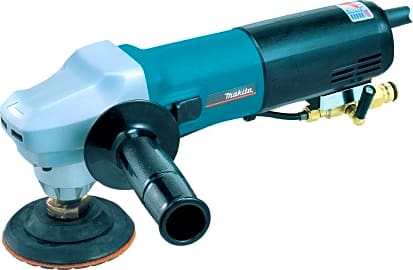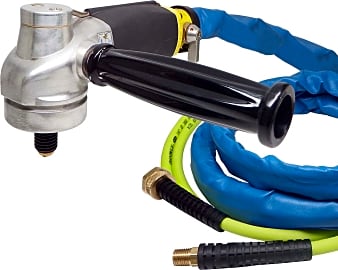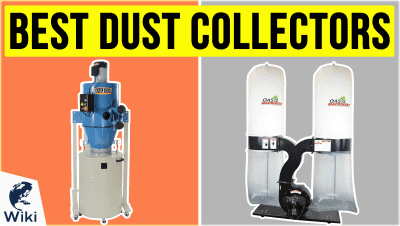The 8 Best Wet Polishers

This wiki has been updated 39 times since it was first published in June of 2015. Perfect for stone and masonry, such as concrete and marble, wet polishers let you achieve a smooth and swirl-free finish on various surfaces. Our selections have been rated based on maximum RPM, comfort, ease of use, and price, so you can find the right tool for your needs. We have included both electric and pneumatic models for occasional DIY use as well as commercial outfits. When users buy our independently chosen editorial picks, we may earn commissions to help fund the Wiki.
Editor's Notes
June 25, 2021:
Ultimately, the Hardin TRH3-K received a consistently worrying amount of poor long-term reviews, and we can't recommend something that could potentially short out in the middle of a job, so we've removed it. That was the only change me made this round. Still occupying the top spot is the Gison GPW212, because professionals working with wet sanders will generally prefer air tools. If you need something more portable, though, the Makita PW5001C is a perfectly fine choice that doesn't spin up as fast as a pneumatic model, but is every bit as dependable and well made.
January 09, 2020:
Added the Gison GPW212 and the Alpha Tools AIR-680.
Pneumatic tools are nearly always preferable to their electronic counterparts when there is access to a large air compressor since they allow you to get more done in much less time. Both the Gison and the Alpha come with a standard 5/8ths shaft for which there are plenty of attachments available on the market. As with most pneumatic tools, these feature mostly metallic internal components and no electronics which might be fouled by the constant exposure to moisture. If properly lubricated, they'll outlast most electronic models even when their circuits come adequately potted.
Pneumatic sanders, polishers, and grinders have a high airflow demand so make sure you have a compressor to meet the needs of your tool. The flow requirements for polishers and sanders will typically range from 15 to 30 cubic feet per minute at about 85 pounds per square inch but you should confirm this in the manual.
If used dry, both electric and pneumatic sanders/polishers produce hazardous dust. Always use breathing protection to avoid health complications.
Wet Polishing Versus Dry Polishing
Dry polishing pads are generally more expensive, as they make use of a harder resin and also need to be able to cope with higher temperatures.
When looking to create a beautiful finish on granite, marble, concrete, porcelain, and other hard surfaces, you have two choices: wet polishing and dry polishing. Wet polishing uses water as a lubricant to cut down on friction and prevent the diamond abrasive pads from overheating. Reducing the friction and heat not only increases the life span of your polishing pads, but can also increase the lifespan of your polisher, since its motor won't have to work as hard.
Another major benefit to wet polishing is that it significantly reduces the possibility of breathing in harmful airborne contaminants created from polishing. The water wets the dust and other particles released during polishing, essentially trapping them before they can become airborne. Unlike with dry polishing, you won't be required to wear a respirator or use a dust collection system. One of the drawbacks of wet polishing is the amount of slurry it creates. Slurry is a mud-like mixture of water and stone or concrete particles that requires extensive clean up. When operating a wet polisher, you will also need to wear full-length rubber apron to prevent the slurry from soaking your clothes.
Wet polishing pads are usually made from a combination of diamond particles and resin. Wet diamond pads are safe to use on almost any type of stone or concrete surface. The pads themselves are usually less expensive than the type of pads dry polishers require, though the polishing machinery is often more expensive, as it has more working components.
Dry polishing doesn't make use of any water, which is why it releases such a large amount of fine dust particles into the air. This is why it requires the use of a good quality respirator. On the other hand, it doesn't create slurry, which often makes it a better choice for use in finished homes or for small polishing jobs. Dry polishing is also more effective at removing surface material, since it is creates more friction. For this reason, many contractors use dry polishers during the initial stages, and then switch over to a wet polisher for the finishing stages.
Dry polishing pads are generally more expensive, as they make use of a harder resin and also need to be able to cope with higher temperatures. While wet polishing can be performed on hard materials, dry polishing is usually a better choice for dense concrete or granite because it will take less time to complete the job.
Choosing The Right Polishing Pad
Oftentimes, the quality of your polishing job will come down to whether or not you picked the right polishing pad. Choosing the wrong pad can result in swirls, gouges, and other unwanted damages to the surface. First, consider the size of the area you will polish. Large diameter pads are the best choice when you need to polish a large, flat surface, but they can be problematic on thin or contoured areas. They will often become unstable on narrow strips and edges. Small diameter pads are better suited to narrow strips and edges, but have a tendency to gouge when you use them on large, flat surfaces. Wet polishers with five-inch pads are a good compromise between being too large and too small. They can handle edges and narrow areas well enough, and are easy enough to control that you probably won't gouge large, flat surfaces.
Large diameter pads are the best choice when you need to polish a large, flat surface, but they can be problematic on thin or contoured areas.
Next, consider the thickness of the pads that come with your machine, or of those you are looking to buy. Diamond pads generally range in thickness from 2mm to 8mm. Thicker pads last longer, but are stiffer, making it harder to use them on curved surfaces.Thinner pads won't last as long, but are better suited to contouring the edges of a sink or countertop. It is usually a smart idea to have pads in a variety of thicknesses on hand, so you are ready to tackle any aspect of the job.
Finally, you'll want to consider the grit rating. Always use pads with a high grit count for polishing. Be wary of any pad with a 400 grit count or less, as they do more grinding than polishing. If you need to remove a little bit of material to level out the surface as you polish, a pad with 400 or 500 grit is perfect. If you are trying to remove the least amount of material possible and only looking to create a mirror-like polish, choose a pad in the 2000 to 3000 grit range.
Tips For Using A Wet Polisher
When using a wet polisher, always turn the water on before you start grinding. These machines are not meant to be used dry, nor are the pads. Using a wet polisher without water can cause damage to both the machine and the pads. To start, turn the water feed on and set your grinder to maximum water flow. Hold the polisher above the surface you are going to be working on, and then turn it on. Slowly lower it onto the surface. You do not need to put much pressure on the machine; let the weight of the tool do the work for you.
Using a wet polisher without water can cause damage to both the machine and the pads.
Once you start polishing, it is time to adjust the water flow down to optimum levels. Too much water will create a bigger mess, while too little water causes excessive wear on the tool and pad. Slowly adjust the water level until it just begins to run clear as you polish. If the water looks very muddy, it means that you have your water flow too low. If it is spraying everywhere, you have your water flow too high.
When polishing, keep the pad as flat as possible to minimize the possibility of gouging the surface. Slowly move the machine around in a circular motion. Never stay in one place for too long. To stay safe, always wear a pair of rubber gloves. This protects your hands from cuts and nicks, and can also reduce the chance of electric shock. If working on a porous surface, like concrete or granite, apply some densifier after polishing with a 600 to 800 grit pad. This will help it shine more when you finish polishing with your higher grit pads.













